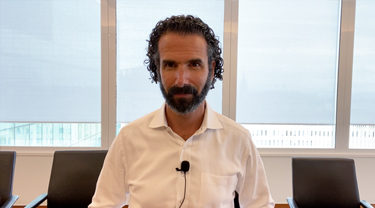When climbing a mountain, the focus is usually on reaching the peak. With a gaze firmly fixed on the summit, the way up can seem easier than the way down. But it’s often on the descent when trouble strikes, as sheer mental and physical exhaustion can lead to costly mistakes, with sometimes painful consequences.
As global inflation returns to a more acceptable range, central banks in advanced economies—with the notable exception of the U.S. Federal Reserve—have taken steps to begin easing monetary policy. But, together with price increases, higher-for-longer interest rates have pressured the economic outlook in many countries. This has left policy-makers grappling to find their footing, all while navigating economies squeezed by tighter financial conditions.
In our summer Global Economic Outlook (GEO), EDC Economics expects the global economy to see modest growth of 3.1% in 2024, as key central banks begin their policy rate descent. In 2025, growth will increase to 3.5%, as the lagged effects of interest rate cuts and a more stable price environment improve demand conditions.
A weak outlook for Canada’s economy is one of the key factors that caused the Bank of Canada to take the lead once again among G7 central banks, cutting rates at its June meeting. We forecast growth of 1.1% for the Canadian economy in 2024, before improving to 1.9% in 2025.
You should also check out
With growing risks, Canadian companies face new challenges. EDC’s Global Economic Outlook offers insights to help you make better business decisions.
While interest rates have started to come down, more is needed to ease the pressure on the heavily indebted Canadian consumer, as total household debt payments increased by nearly 8% in the first quarter of 2024, compared to a year earlier. An elevated debt service ratio, among the highest in the Organisation for Economic Co-operation and Development (OECD), has caused Canadians to focus on saving rather than spending.
As demand cools, businesses will take a breather on near-term spending plans again this year, before rebounding in 2025, alongside easing borrowing costs and firming demand conditions. This relatively soft backdrop, together with the Bank of Canada’s trailblazing policy moves, will cause the loonie to fall to an average US$0.72 in 2024, before jumping to US$0.75 in 2025, as the policy gap closes.
Continued momentum in the U.S. economy, and persistent inflation, has forced the Fed to keep its powder dry so far this year. However, the gravitational pull of higher interest rates appears to be catching up with the labour market, curbing the pace of job gains and moderating wage increases from their peaks of the last few years. Slower hiring and wage growth, coupled with depleted pandemic-era savings, will wear on consumer demand and overall U.S. growth through the second half of 2024. We expect the U.S. economy to post growth of 2.3% in 2024, and 1.8% in 2025.
A weaker second half will set the Fed up for a late-year rate cut, beginning its cautious descent, while keeping close watch of inflationary pressures. At this pace, U.S. interest rates will experience some divergence from other major economies, providing some lift to the U.S. dollar and putting other currencies under pressure.
While euro weakness will provide a minor boost to European exports, it won’t be enough to propel overall growth. We forecast euro Area growth of just 1% in 2024 and 1.7% in 2025. In Germany, the region’s industrial engine, capacity utilization continues to be the weakest in recent history, outside of the COVID-19 and global financial crisis periods. France will also continue to post below potential growth, but a somewhat resilient consumer should be emboldened by declining interest rates and the impacts of the Paris Olympics.
China’s economy will continue to face challenges, though it’ll record growth of 5% this year and 4.6% in 2025. While these would be impressive growth rates in many parts of the world, for China, this is a step down from its pre-pandemic peaks. Despite targeted government support measures, ongoing impacts of the property sector collapse, together with weak consumer and business confidence, will cause domestic activity to underwhelm. Exports, meanwhile, will be constrained by ongoing retaliatory protectionist measures and still-soft global demand.
The relatively modest global outlook in 2024 will translate into a soft environment for commodity prices. Copper and gold have been exceptions to this trend, driven mainly by idiosyncratic factors—like the energy transition, supply constraints, geopolitical volatility and speculative activity—which we expect to continue through the second half of the year. West Texas Intermediate oil prices are forecast to average slightly less than US$81 per barrel in 2024, before dropping to around US$75 per barrel in 2025, as supply growth continues to outpace demand growth.
The bottom line?
While reaching the summit requires strength and endurance, discounting the descent can lead to a world of trouble. As central banks begin the slow climb down from their historic rate hikes, they’ll need to be cautious to avoid any policy missteps, ensuring growth returns to economies while inflation remains in check.
This week, special thanks to Ross Prusakowski, director of our Country & Sector Intelligence team.
As always, at EDC Economics, we value your feedback. If you have ideas for topics that you’d like us to explore, please email us at economics@edc.ca and we’ll do our best to cover them.
This commentary is presented for informational purposes only. It’s not intended to be a comprehensive or detailed statement on any subject and no representations or warranties, express or implied, are made as to its accuracy, timeliness or completeness. Nothing in this commentary is intended to provide financial, legal, accounting or tax advice nor should it be relied upon. EDC nor the author is liable whatsoever for any loss or damage caused by, or resulting from, any use of or any inaccuracies, errors or omissions in the information provided.






